#thrifty acres
Text
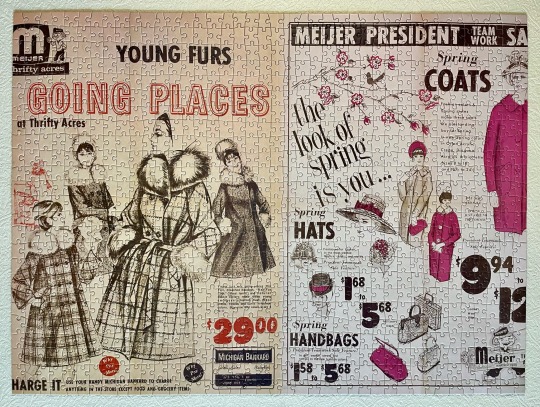
2024-02-03, 1000, “Meijer Fashion Ad”
#1000#jigsaw puzzle#jigsawpuzzle#jigsaw#puzzle#complete#meijer#meijer thrifty acres#thrifty acres#why pay more#Michigan#grocery#vintage#advertisement#ad#hats#coats
2 notes
·
View notes
Text
There Are Many Luxuries I Can't Live Without
Daily writing promptWhat’s the one luxury you can’t live without?View all responses
There are many luxuries I can’t live without; a sizable House on Acres of Property, having more personal space to myself, Air Conditioning, Heating, the Thermostat for both the Furnace and Air Conditioning being set for thrifty, frugal, and economical temperatures; new Cars as daily drivers, used Cars as…

View On WordPress
0 notes
Photo





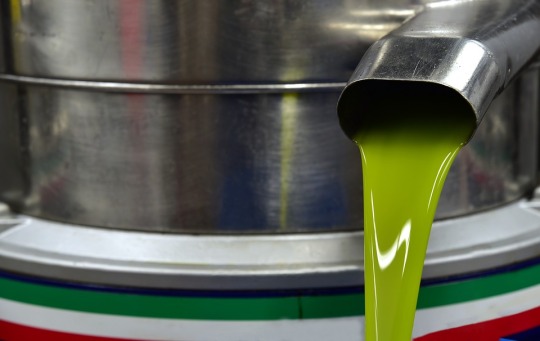

Le foto sono di Ulleo
E’ tempo dell’olio nuovo
C’è qualcosa che unisce tutti i popoli del mediterraneo, da Gibilterra a Istanbul o da Genova a d Alessandria d’Egitto, o Haifa. Questo qualcosa è l’olio. Ora, nella cultura cinese e giapponese, a tavola non si mettono mai coltelli perché il coltello vuol dire guerra, assenza di armonia e quindi pace. Queste due culture esprimono il bisogno di serenità e rispetto l’uno dell’altro, con l’assenza a tavolo di un simbolo di disaccordo: una lama tagliente. Nella cultura mediterranea, l’augurio e il desiderio di armonia e di pace, si riassume nell’olio, negli ulivi che silenziosi guardano il mare e nel silenzio vivono oltre il nostro tempo, privilegiati dal loro vivere in modo parsimonioso e umile. Ti ho già raccontato, più volte, e con molti dettagli, di come da piccolo, vivendo di fronte ad un frantoio, vedevo le olive trasformarsi in olio, all’inizio brusco e vivace, morbido e seducente nel passare del tempo. Ogni cosa che l’olio toccava diventava buonissimo: il pane caldo con lo zucchero, il pomodorino lasciato a maturare appeso al soffitto, i broccoli bolliti, e saltati in padella, il fegato arrostito avvolto nel grasso, le zuppe di lenticchia o di ceci. Tutto quello che la terra, o la fatica degli uomini ci donava, l’olio lo rendeva, magnifico, insuperabile. Ne esaltava il profumo e il gusto senza coprirlo o dominarlo. Era come il cielo che colora il mare o il sole al tramonto che rende rosa le nuvole. Era la natura a cui l’uomo restituiva l’amore che gli mostrava, trasformando l’acre oliva in un tesoro, in un simbolo di pace con cui l’uomo si nutriva per perdere il suo sapore acre, i suoi denti da Caino e credere di non essere un unico, ma parte di una famiglia che va da Gibilterra ad Istanbul, da Genova all’Egitto e capire che sotto lo stesso cielo, di fronte allo stesso mare, nutriti dallo stesso albero, siamo nella stessa casa, uniti dallo stesso amore.
There is something that unites all the peoples of the Mediterranean, from Gibraltar to Istanbul or from Genoa to Alexandria in Egypt, or Haifa. This something is the olive oil. Now, in Chinese and Japanese culture, knives are never placed at the table because the knife means war, absence of harmony and therefore peace. These two cultures express the need for serenity and respect for each other, with the absence of a symbol of disagreement on the table: a sharp blade. In Mediterranean culture, the wish and desire for harmony and peace is summed up in the olive oil, in the olive trees that silently look at the sea and live in silence beyond our time, privileged by their living in a thrifty and humble way. I have already told you, several times, and with many details, of how as a child, living in front of an olive oil mill, I saw the olives turn into oil, at first abrupt and lively, soft and seductive over time. Everything the oil touched became delicious: the warm bread with sugar, the cherry tomatoes left to ripen hanging from the ceiling, the boiled and sautéed broccoli, the roasted liver wrapped in fat, the lentil or chickpea soups. All that the earth, or the effort of men gave us, the olive oil made it magnificent, unsurpassed. He enhanced its aroma and taste without covering or dominating it. It was like the sky that colors the sea or the setting sun that makes the clouds pink. It was nature to which man returned the love he showed him, transforming the acrid olive into a treasure, into a symbol of peace with which man ate in order to lose its acrid taste, his Cain's teeth and believe that you are not one, but part of a family that goes from Gibraltar to Istanbul, from Genoa to Egypt and understand that under the same sky, facing the same sea, fed by the same tree, we are in the same house, united by same love.
28 notes
·
View notes
Note
I feel that the Queen is nothing but pragmatic and thrifty (wartime generation lol). She would see no point in having an empty house that just had a tonne of renovation done. She had a grandson that didn't want to live in the UK and a pregnant granddaughter who wanted a private property. It's a great solution to this mess - no abandoned house, someone actually paying rent, and subtly answers questions about your grandson's future role and intentions.
Allowing Eugenie and Jack to move into Frogmore Cottage, could not have been an easy decision, especially given the history between the two couples. I can’t help but think that this is a set up for something else that is in the works. Eugenie and Jack weren't hard up for a place to stay, they are well off and don’t need a house that comes with so much baggage and headache. Jack is worth millions and Euginie’s parents live in a huge property with 7 bedrooms set on 21 acres! I feel that Eugenie and Jack have been called upon by the BRF to fulfill a duty to the family, and the final reward won’t just be the roof over their heads....
38 notes
·
View notes
Text
“A Trip Over the Transit Railroad”
by Joanna Grey Talbot
In 1883 journalist A. L. W. took a trip on the Transit Railroad in Florida, which connected Fernandina on the Atlantic to Cedar Key on the Gulf. They shared their experiences in an article published on the front page of the May 15, 1883, issue of the The Weekly Floridian in Tallahassee.
Let’s follow along as they visit 10 towns along the route.
“The majority of persons living in Middle Florida, whose business or pleasure has not railed them to the Eastern part of the State, have very little idea of the material progress, the great influx of immigration, I lie important industries, or the rapid development of the country along the line of the Transit Railroad, which connect Fernandina, the best harbor on our Atlantic coast, with the important port of Cedar Key on the Gulf of Mexico; nor is it possible in the short scope of one letter to convey more than a general view of this very important portion of the State. The traveller from Middle Florida, after a night spent in the comfortable sleepers of the Florida Central and Western Railroad, which is under the efficient management of Major W. M. Davidson, a Middle Florida man, strikes the Transit road at…”

Hotel Oliver, Baldwin, Florida, courtesy of the State Library and Archives of Florida
Baldwin
“…long a very important transfer point for freights for the line of the Transit road. Cedar Key and the Gulf coast, which formerly came from the North and West via Savannah and Live Oak, but which, since the completion o! the Waycross “Short Line," is now delivered to the Transit system at Callahan, twenty miles north of Baldwin. […] The lumber industry along this road is immense, as is attested by the long trains of heavily loaded flat cars which were passed at various points; in fact, the monotony of the pine forest was almost constantly broken by a panorama of saw mills, young orange groves and handsome residences seen from the car windows as we sped along, till proving the existence of an industrious and thrifty population, each contributing his quota to the prosperity of the road and the material progress of the State. The towns of Highland, Lawty and Temples were passed when the brakeman called out…”

Call Street, Starke, Florida, courtesy of the State Library & Archives of Florida
Starke
“twenty minutes for dinner and alighting from the train we proceeded to the “Railroad House," kept by Mr. Kleinsmidt, an industrious German, who owns a farm and orange grove near town, while his estimable wile and charming daughters vie with each other in serving the tired traveller with all the good things which go to make up a first-class dinner. […] There are several groves in the vicinity, some bearing, while most of them are young.— In the town new houses are going up on all sides and the song of the saw and hammer is the music which greets one at every turn. […] Speeding along we soon reached…”

Seaboard Depot, Waldo, Florida, courtesy of the Matheson History Museum
Waldo
“…the junction of the Transit with the Peninsular Railroad. Here we switched off the through coach which is run daily from Jacksonville to Wildwood, thus obviating the necessity of a change of cars between these points. Waldo has a fine hotel, a cigar factory, several stores and churches, and is the terminal point of the Santa Fe Canal, which brings the fine orange country of the lake region within easy access of the railroad. […] Our next stopping place…”

Arlington House advertisement in the “Eden of the South,” 1883, courtesy of the State Library & Archives of Florida
Gainesville
“…the metropolis of East Florida, is a city of about four thousand inhabitants and the county site of Alachua, one of the richest agricultural counties in the State. […] Besides its numerous stores and other business places Gainesville has a bank, a cotton seed mill, three ginning establishments, three livery and sale stables, two depots (the Transit and Florida Southern), two first-class hotels, the Arlington and Varnum House, (the former about the size of our Leon) and quite a number of boarding houses. I have not space in this letter to devote to the above business enterprises the attention which each deserves. […] Six miles further on we come to…”
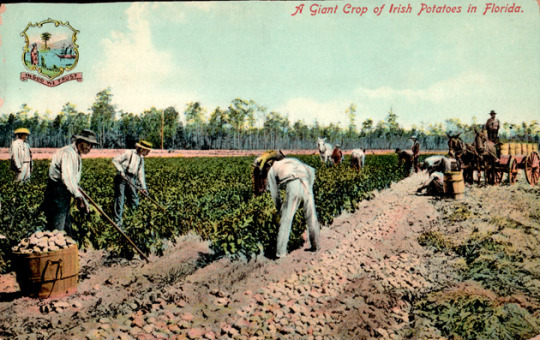
A Giant Crop of Irish Potatoes in Florida, courtesy of the Matheson History Museum
Arredondo
“…the boss vegetable station of the Transit road. I have not spoken of this industry heretofore because I was at a loss how to convey to the minds of your readers a just idea of the magnitude of this business on the line of the Transit and Peninsular roads. All along we had observed at the different stations large lots of vegetables in crates waiting shipment but here we saw the entire platform covered with piles on piles of crates filled with, beans, cucumbers, peas, Irish potatoes and cabbage […]. Some idea of the extent of the business may be gleaned front the fact that twice a week, Mondays and Wednesdays, an extra train far vegetables only, is run from Bronson to Fernandina to connect with the steamships of the Mallory line, in addition to the daily freight train.

Church Street, Archer, Florida, courtesy of the Matheson History Museum
Archer
“…also in Alachua county, is a live little town with five or six stores, and contributes its quota to the vegetable business. Peach culture has here been brought into some imminence by the Rev. J. P DePass, well known to many in our section.”

A.H. Bateman and family in front of their home in Bronson, ca. 1910, courtesy of the State Library & Archives of Florida
Bronson
“…the county site of Levy County, is distant from Cedar Keys about thirty-five miles. It has four stores, and besides being the shipping point of a vast scope of country for miscellaneous exports such as cotton, hides, wax, etc., being situated in the midst of a fine grazing country, large numbers of beef cattle are annually shipped from here to the markets of Savannah and Charleston. After passing Otter Creek, a flag station, we next arrive at…”
Rosewood
“…the residence of C. B. Dibble, Esq., who, in addition to his orange grove, has developed an entirely new industry; you who are familiar with the lovely flower gardens of the Floral City, just think of eight or ten acres in Tube Roses. The flowers are sold in Gainesville, Cedar Keys and other places, while the bulbs are shipped North, and I am told the proprietor has found it profitable. Soon after leaving this station we pass through a spur of the far-famed…”
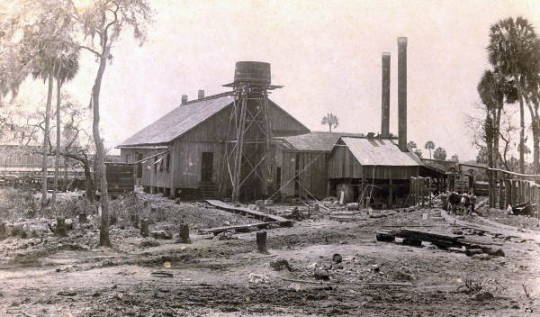
Gulf Hammock fiber factory, ca. 1890, courtesy of the State Library & Archives of Florida
Gulf Hammock
“…probably the largest and finest body of hammock land in the State, whose sylvan depths furnish alike wealth to the enterprising cedar cutter, and the fattest turkeys and juiciest venison which ever tickled the palates of tourist epicures at the Egmont and St. James. Swiftly skimming over the few remaining miles we soon alighted at…”

Bird’s Eye View of Cedar Key, 1884, courtesy of the University of Florida Digital Collections
Cedar Keys
“…the Venice of the Gulf, whose cool sea breeze, fresh from the “cradle of the deep," tanned our (very dusty) brows, and tossed the smoke-plumes of our locomotive in fantastic wreaths and curls, the same whose shrill whistle had in the early morn mingled with the hoarse roar of old ocean as he piled his white-capped waves high on the smooth beach at Fernandina. […] Cedar Keys has been so often written up, and is so well known by reason and its importance as a Gulf port, that any attempt of my weak pen to do it justice would be futile. […] The principal industries of Cedar Key are its lumber mills, of which there are four or five for the manufacture of pine lumber, and two cedar mills belonging respectively to the Faber and Eagle Pencil Companies. In addition to the above its export of fish and oysters is a source of great revenue, while its sponge trade is by no means an inconsiderable item of its business. […]
“I have already spun this letter out to more than double my original intention, and yet “the half remains untold,” for one could find material for many letters in the beautiful little city of Cedar Key, and its adjacent Islands, bays and rivers, which I left with regret, feeling that next to the breezy hills of Tallahassee I would rather live on the lovely Gulf Coast of Florida.”
The full article can be viewed here via the Library of Congress’s Chronicling America database: https://chroniclingamerica.loc.gov/lccn/sn82015289/1883-05-15/ed-1/seq-1/.
2 notes
·
View notes
Text
In mid-March, Freddie L. Brown Jr. (59) began feeling ill. He to a local hospital, but was told that he did not meet the Centers for Disease Control’s testing criteria and was sent home. He went to bed ice cold and woke up sweating through the sheets. He became tired and nauseous. His muscles felt like they were being stabbed by knives. When his conditioned worsened, he was to Ascension Genesys Hospital in Grand Blanc Township. On March 22, he began to have trouble breathing, so the staff prepared to put him on a ventilator; required him to be put into a medically induced coma. Three days later, his lung collapsed and on March 26, 2020, Freddie Brown Jr. died after battling coronavirus.
On March 27, one day after his dad died, Freddie III (20), who had asthma, became sick. It started with a slight fever and he also began to cough. The next day his mother took him to Ascension Genesys, and a day later he was feeling better. Sandy Brown was relieved over her son’s initial progress. She celebrated on Facebook, writing she was rejoicing like a crazy woman all over her house. “Every church I enter I will be shouting down the aisles!” she wrote. “So please excuse me now for my disruption! Do you hear me! I will be shouting the victory in your face!” But just as quickly as Freddie III’s condition had improved, it began to deteriorate. Three days after his father's death, Freddie III also succumb to COVID-19.
Freddie L. Brown Jr. worked for Meijer Thrifty Acres as a produce clerk and retired after 32 years of dedicated service. He was a church elder and national service member with the Church of God in Christ. Freddie Jr. was such a fashion plate that Flint-area ministers frequently sought his advice to look their finest. Freddie III also was a football fanatic who dreamed of playing for Michigan State University next year as a walk-on. #COVID19VictimRemembered
Visit the COVID-19 Victims Memoriam Facebook Page at fb.me/covid19.victim.memoriam and the COVID-19 Victims Memoriam Tumblr Page https://covid-19victimsmemoriam.tumblr.com



1 note
·
View note
Text
Potato Commentary
Today is #PotatoPoTuesday and we have the back of a potato postcard from the 1980s: “The Idaho Potato is featured on the menus of the swankiest supper clubs of the land, yet it is the favored and most thrifty food of the modest. Idaho now devotes 242,500 acres to produce 114,900 car loads which is 25% of the nation’s total, the greatest of any State!”
Postcard courtesy of MA2018-13 Keith Peterson Papers, University of Idaho Library Special Collections and Archives
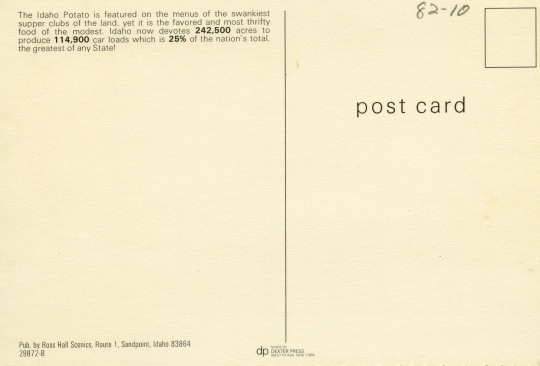
11 notes
·
View notes
Text
Andrew Kehoe - The Bath School Disaster



On May 18th 1927, the small town of Bath Township, Michigan, was forever tainted with the horrific events that occurred due to the actions of one man. A farmer and treasurer of the local school board, Andrew Kehoe, murdered his wife and then went on to detonate bombs around the Bath Consolidate School. He then committed suicide by detonating the truck he was driving in while inside. The death toll, including Kehoe, was 45, many of whom were children around the ages of 7-12. 58 others were injured. This tragedy claims the title of the deadliest mass murder in a school in US history.
The perpetrator in all of this was born on February 1st 1872 in Tecumseh, Michigan. He was one of the youngest children in a family of 13 to Philip and Mary Kehoe. At the age of 5, Kehoe's mother passed away and his father remarried a woman named Frances Wilder. He did not get along with his step-mother, and when she caught on fire while trying to light the stove when he was 14, he watched her burn for a few minutes before attempting to put out the flames. However, his efforts were futile as Frances eventually succumbed to her injuries and died. Rumours spread that the stove had been tampered with to deliberately injure Francis, with many speculating whether Andrew was the culprit.
Kehoe attended Tecumseh High School and Michigan State College, where he studied electrical engineering. It was at this college that he met his future wife – Ellen “Nellie” Price – who was the wealthy daughter of a family from a nearby Michigan town. After graduating, Andrew travelled to St Louis, Missouri, for work. However, in 1911, Andrew developed a severe head injury after a fall and drifted in and out of a coma for 2 months. He eventually returned to Michigan and married Ellen in 1912. With money given by her family, they were able to purchase an 185 acre farm outside of Bath Township in 1919.
Due to accounts that neighbours, friends and families gave about Andrew, it is easy to see the telltale signs of a future mass murderer. He was regarded as being intelligent but had a very short temper, even growing angry when someone disagreed with him. He was very meticulous and neat, known to change his shirt midday or if he got the slightest stain on it. He was also known to be very cruel towards his animals, once beating a horse to death. Although he and his wife had initially started attending the Catholic Church in Bath, he refused to pay the church and prevented his wife from attending these services.
Kehoe was also known for being very thrifty, and became the treasurer of the Bath Consolidated School Board. He used this new position of power to campaign for lower taxes, claiming that they were causing him financial hardship, often accusing the superintendent of financial mismanagement. He was appointed as the Bath Township Clerk in 1925 but was defeated in the 1926 election, which upset him greatly. Neighbours suspected that Andrew was planning revenge against the community and may even be considering suicide, as he had ceased working on his farm for about a year. During this time, Ellen became chronically ill from tuberculosis and had to attend numerous hospital visits. Andrew also stopped paying mortgage and homeowner's insurance payments – foreclosure proceedings had even been imposed on the farm. It seemed as though everything he once had, he lost quickly, which may have been one of the main causes for him to turn to such drastic measures.
Before the fateful day on May 18th, Andrew loaded the back seat of his truck with metal debris and replaced the tires for his truck to avoid breaking down while transporting these explosives. He purchased explosives from nearby towns in bulk to prepare for the tragedy. Ellen was discharged from her most recent hospital visit on May 16th. Between this time and the bombings, her husband had murdered her and left her body in a wheelbarrow located near the chicken coop on his farm. He then placed explosives all around his farm and the house, keeping his animals tied up to avoid them escaping during the chaos.
At approximately 8:45am, the firebombs in his house and farm buildings were detonated. Debris flew into a neighbour's farm, which caused the emergency services to be called and volunteers to be rushed to the scene. They found Ellen's body in the wheelbarrow in a heavily charred condition after the explosions surrounded by silverware and ashes of bank notes. As firefighters were trying to put out the fire, Kehoe yelled at them to go to the school instead as he drove off to the school.
Classes at Bath Consolidated School started at 8:30am – Kehoe had set an alarm clock, connected to dynamite and pyrotol, for 8:45am under the north wing. Firefighters heard the explosion of the school from the farmhouse and rushed towards the school. 38 children were killed in the initial explosion, most of which were children. The north wing of the school had completely collapsed, crushing and trapping multiple children.
About half an hour after the explosion, Andrew drove towards the school. He summoned Superintendent Huyck, the one who he accused of financial mismanagement. He then detonated the dynamite stored in his truck with a long gun, killing himself, the Superintendent, a retired farmer a postmaster and another child who had survived the initial explosion.
Despite the tragedy that had occurred, the small community banded together to help rescue and heal the wounded and trapped. Nearby towns sent over their firefighters and other emergency services – there were 34 firefighters on the scene, alongside several Michigan State Police officers. The governor of Michigan, Fred W. Green, arrived during the disaster and assisted in the relief work. Investigators found a wooden sign wired to Kehoe's farm fence, saying, “Criminals are made, not born.”
The town of Bath Township to this day still commemorates the day that they lost many innocent lives, many of which were children who never had the chance to live their lives. The Bath School disaster remains a tragedy that reigns even true in today's time, with rising amounts of school shooters.
#true crime#true crime community#tcc#tcr#informational#true crime research#andrew kehoe#bath school disaster#own post
41 notes
·
View notes
Text
STARVATION - ONLY THREE DAYS AWAY IN HAWAI`I

Big Island Now - May 21, 2019
Hilo (population 45,648) has the priciest groceries of any American city. Hawai‘i is known for having a high cost of living, but with such a great climate for agriculture, why don’t we produce enough food to affordably sustain our population?
The Problem
Janelle Saneishi, public information officer of the Hawai‘i Department of Agriculture, informed us that an estimated 3,000 tons (6 million pounds) of food are imported on a daily basis, according to the Hawai‘i Emergency Management Agency (HI-EMA) at a cost of more than $3 billion dollars per year.
Part of the reason food is so expensive is because importers and producers have to increase prices to account for having nearly a third of the food that is imported spoils due to the hot, humid climate before it reaches the shelves.
And climate change has the potential to raise costs even more in upcoming years.
In addition, at least half of the seafood we consume comes from the mainland.
Surprisingly, Hawai‘i’s top agriculture export isn’t meant for consumption, including seeds (about half of which are genetically engineered, according to the Hawai‘i DOA). Seed exports were more than twice as valuable as our No. 2 export, macadamia nuts, followed by cattle and coffee. But not all seed crops in Hawai‘i are genetically engineered (GE).
About half of all seed crops grown in the state are conventional crops. GE seed crops are not grown on the Island of Hawai‘i. You would think, given the markup cost of imported food, we would be able to produce our locally for less money—but we don’t.
The Hawai‘i DOA explained that farmers may be discouraged to produce more because there is a bigger profit margin in producing less. “Hawai‘i has about 1.135 million acres statewide designated as agricultural lands (catch-all),” Saneishi shared with Big Island Now. “These lands include gulches, ravines and steep terrains that are not suitable for growing crops.
The 2017 agriculture census estimated total harvested cropland in Hawai‘i at 84,767 acres. Additionally, property rights and free enterprise in the Hawai‘i/U.S. permit farmers and ranchers to freely choose how much to produce or not produce.
Usually, they are motivated to provide more, with higher market prices and higher profits. Government cannot dictate that farmers grow more food.
Additionally, the law of supply rules that a higher quantity of supply produced will lower market price with constant demand and thereby lowering profits to farmers....”
How You Can Help
When evaluating the importance of “eating local,” residents should be aware that currently, if a natural disaster were to occur and barges were to stop, it is estimated there would be only three days worth of food left on the shelves in local grocery stores.
Local grocery stores like KTA are also trying to encourage more people to buy local to increase demand and help motivate local farmers.
KTA Super Stores Executive Vice President Derek Kurisu, told Big Island Now, “We advertise a lot in our print ads, radio, store signs and speeches to various organizations and classrooms. The emphasis is to promote locally grown or manufactured products. Our private label, Mountain Apple Brand, consists of locally grown or manufactured products.”
Many fruits and vegetables are actually cost-competitive with imported produce. UH found that 80% of our tomatoes and all of our watercress are produced locally. According to the Hawai‘i DOA, consumers can be thrifty shopper while supporting local products by making sure to purchase watermelons, mangoes, avocados, apple bananas, dragon fruits, cabbages, Mānoa lettuce, basil, sweet potatoes and macadamia nuts that are produced locally.
Kurisu told Big Island Now that at KTA, “95% of our leafy vegetables in the produce department are locally grown; 100% of our papayas, pineapples and bananas are locally grown; 100% of the melons are purchased locally when in season. Our pumpkins are locally grown during Halloween…
In the produce department, we try to support local first. Forty-five percent of our local beef sales are local grass-fed beef; 5% of our pork sales are local and 60% of our seafood sales are from local waters. We import frozen seafood like shrimps, butterfish, etc., due to the lack of supply. About 65% of our fresh milk sales were from local dairy before the closing of Hāmākua Dairy and problems with Clover Leaf dairy in Kohala. Today, local milk makes up only about 20% of KTA’s fresh milk sales. Currently, we are working with Clover Leaf to improve our milk supply, so I am confident that within the next three months, it will go back to 65%.“
Another way to encourage food sustainability on our islands is by substituting your starches such as wheat and rice for varieties that can be produced locally, like taro and breadfruit, which sustained ancient Hawaiians....
3 notes
·
View notes
Text
We go Slavic
Our brief and enjoyable sojourn in Trieste was over and it was time to head for our hire car and the next stage of the trip. We continued to consider southern Italy (East Coast to the boot) vs our original plan Croatia. Googling various potential stops on the way south in Italy (a trip of at least 1000kms) suggested a lot of naff destinations on the way there. What seemed like acres of beach umbrellas and not so many of the quaint little fishing villages or smaller seaside towns which we found in Greece. In this neck of the woods mass tourism is prevailing it would seem. Still, southern Italy the real goal if that's the way we decide to go ie bypass the North and we can always hit the motorways south to speed up the journey. Croatia seemed to have some of the same problems with some pretty busy places. Anyway step 1 which might end up being the prevailing influence on which way we go was would budget rent-a-car let us move countries with the car at a reasonable price. Liz had a bit of a headache in the morning, may have been the spritz or the marginal glass of rose the night before, so had a snooze while I sussed out trains and buses. It's Sunday so we can get a very cheap train ride to the airport (where we pick the car up). 3.30 euros each. That's about A$11 for the two of us compared to taxi fare of 58 euros/A$100 No brainer and only takes half an hour. A taxi would take longer. Liz managed to make breakfast at the hotel which was the same frenetic scene as the day before and we headed for the station about 150 metres away around 11.45. The train train departed at 12.15 and by 1.00 ish we were in the short queue for the car. Very helpful and friendly Budget guy confirmed that no additional cost for travelling into Croatia or Slovenia and no problem taking the car on a ferry. We are now thinking Croatia first, followed by ferry to southern Italy from possibly Split. As ever we had a cheapo car and they were offering a Fiat Panda. Our bags would not fit in the boot so the budget man helpfully then moved us "up" to a Fiat Punto at no extra cost. Budget like thrifty seem to flog their cars a bit more than hertz so they are a bit older. Our car needed detailing given it was a late switch which he swiftly did (well, he vacuumed and cleaned the windows) and we were off with both bags stowed in the boot section. We were headed for Slovenia first, just to pass through on our way to Croatia. Our Budget man advised that we needed to get a pass for 15 euros for the Slovenian freeways or face a 400 euro fine but we could buy one at any garage en route in Italy. We always, where time permits, avoid freeways in favour of more interesting backroads but "Narelle" the trusty voice of Apple maps seemed to have us on toll roads. The hefty fine very much in mind we headed for the town of Muggia in search of the elusive Slovenian freeway pass as somehow no garages appeared on the first part of our journey. Muggia had a pretty pleasant central section and we tried to stop for lunch but like so many small towns in Italy (at least by the sea) there was nowhere that we could find to park so we continued on our way searching for that damn petrol station. We were following the coast around towards Slovenia which was not far away and feeling frustrated that we couldn't buy the pass. The coast road was one long car park with narrow beaches and cars parked much of the way along as people enjoyed the beach and sea. It was Sunday afternoon so we presumed that that was one cause for the crowds though stinking hot around 33 degrees and quite humid. We got to the border and there was a duty free shop which thankfully sold the pass so we could continue on feeling reassured. Of course it is probably a waste of money as we passed through Slovenia and totally avoided the motorways though the pass lasts for a week so who knows? We laughed to ourselves. At around 3.00 we reached Slovenia (no customs) and around 3.45, after a slowish crawl of 20 -25mins in a traffic jam to get through Croatian customs, we were in Croatia. Not hard to move countries and so quickly. Where to now? We headed for Umag which had good crits on various travel sites and reports. After a couple of circumnavigations of town we were not enthused. As a local said to us a few days later. It's a bit industrial looking - and it was. Obviously some nice sections but we either missed them or it just didn't hang together. We moved on. Liz saw the smaller town of Novigrad (Croatian) or Citinova (Italian) - same place. We headed there. This immediately ticked the buttons it seemed smaller, also on the coast but looked quaint and attractive but also quite lively. Now around 4.15. We decided to stay. We parked up and Liz started looking at booking.com. She quickly identified an apartment with good crits (10/10) at an acceptable if not exactly cheap price and we went for it. Other rooms looked pricier. Obviously a town in some demand. While we were looking for a room we had tried to pay an hour or two's parking so we could deliver our bags to the rooms but it was proving tricky to crack the system. My fault partially as I was inserting 2 Kune (local currency) coins instead of 10 Kune so no wonder a prob. However we were also getting some conflicting advice from s local on whether we should be parking where we were. Luckily we had our eyes peeled and the traffic warden was wandering around booking people so I legged it down and explained that we were still in the process of acquiring (not a word I used with him) - ticket so no prob. Close shave. Meanwhile Liz was communicating with the guy at the apartment who was keen for us to get there so he could hand over the keys and no doubt sorph off for tea. He advised that we could go to a local larger car park and park for 24 hours for about A$10/11. We found the park which was absolutely full. A couple of navigations later we struck lucky and were in but still not sorted. Despite our hosts affirmation that we could pay for 24 hours the ticket machine stubbornly refused to allow anything past midnight. A few patrons were gathered around trying to crack the system to no avail. Luckily I had gone into a bar to ask for some advice and the guy had told me you can go to the parking office around the corner and pay there. Liz was still getting angst from our host who was wondering where the heck we were. All a bit of a farce. I called her to advise of my probs getting my hands on a ticket and got a bit of relayed angst. Anyway, I found the parking office, went in, the guy spoke impeccable English said yes he could help and 1 minute later I'm on my way with a 24 hour parking ticket. They don't make it easy. He said the machine would not allow you to do that even though it indicated it would. Ha! I returned to an agitated Liz keen to get the apartment bloke off our back. We grabbed the bags, backpacks, various other bits and pieces and trundled down to the apartment just 200 metres or so away. It was still stinking hot at around 5.30 so arrived in a lather. We had just wasted an hour or so, really on nonsense. Anyway, all good. Apartment guy was very friendly and helpful. Apartment nowhere near 10/10. He must have got his mates to do the crit. Still, adequate and quite roomy and excellently located right smack in the centre of town. Had to laugh after a few hours on the road I needed to visit the facilities and the cheapo plastic seat on the loo was not affixed properly. I nearly fell in. The whole contraption fell apart later and I had to do a reco. It was not a seat for sitting on really unless you were motionless which seems a real contradiction in terms. We decided to head off promptly so had the quickest of showers and then hit town. A drink was in order and we found a nice bar by the sea. Sunset could be watched and passing promenade of people. A nearby restaurant similarly situated by the sea also looked good and we opted for that. I had the sea bass fillet and Liz crusted Tuna. Bass was magnificent, tuna good but a little less rare than Liz would have liked. Portions quite large though and neither of us could fully finish. The wine is better here than in Greece though they seem to follow the Italian style with measures which are restrained to say the least. Glasses with 0.10 mls. In Greece they give you that as a taster. Though wine basic in Greece. We had a great night, relaxing, good food. Great atmosphere. The town was pretty lively too without being over the top. Post dinner we walked around the little funfair which had dodgems which were hilarious to watch with cars crashing and backing into each other and much jolliment amongst the patrons Also other madcap rides which for us would have seen dinner re-appear. Finally we strolled back along the beachfront sort of up on the prom. Our host had said there was a bar where music was played and we found it. We didn't go in just sat on the wall above it for probably 45 mins listening to the two person female band. Both on guitars and one with a very powerful voice. They sang a variety of love ballads but not schmaltzy, some quite funky and quite a few that you knew but couldn't quite name. Shazam was employed. Really nice end to the evening. One fortuitous thing we did was literally stumble across a little hotel as we wandered around town. The Santa Marija. We asked if they had a room for the following night and yes they did including breakfast. Price acceptable. Smack in town and certainly the establishment looked better than our current joint. We couldn't check the room until the 10.00am the following morning but it was going to be a no-brainer. The lady said she would hold it for us. The next morning Liz was down there just after 10.00 and the deal was sealed. We left our digs not long after and checked straight in at the Santa Marija this was more like a 10/10, the other place - 8.0 based largely on location and certainly not the fragile latrine. Our biggest task now was to find a beach seat. Straight down there and there was plenty of choice at around 11.00. Liz went in search of some breakfast (toasted sandwich) and brought me one to the beach. We just did the usual and read, slept, blogged, watched the passers by and generally chilled for the rest of the afternoon. Heading back to the digs around 6.00pm. Dinner was very pleasant. Different place. Sticking largely to the seafood. Liz the grilled squid which was excellent and me the sea bass with grilled vegetables which was the same. Not really large portions but very rich and very filling. Liz risked the Rose which I had to polish off though was a notch up on Greek offerings. Really friendly waiter too. We had front row seats just off the prom and just soaked it all up. Post dinner bought some ice creams and floated around town ending up above the same bar as last night but different musos tonight. We were in for a treat. 3 man band, good sound and lead singer had a great voice and was the most manic guitar strummer we have ever seen. He set the place alight and second song was of all things " Men at Work - Down Under". The bar was fuller tonight and after each song applause were pretty loud. Of course we loved MOW but plenty more - "Without Love - The Doobie Bros" comes to mind so just lots of rock classics all belted out and the guitar thumping. We headed home pretty happily after a great day. We are realising how much we are enjoying smaller towns rather than the big ticket places. Also we are feeling less inclined to head out of our way to see the Roman ruins etc and other sights unless of major significance. Little villages/ small resort towns are our preference if we can find them. The car is pretty handy here as you can stop or go a you please. Liz did very well sniffing out Novigrad as it really doesn't get too many mentions in travel blurb (including Lonely Planet) yet for us was a gem.
1 note
·
View note
Text
Near Blue Bell Hill
Origin of Aylesford
Aylesford, Kent is an old, rustic village believed to have existed even during the Neolithic times. It is a large village on the River Medway, accessed via a medieval five-arched bridge. The origin of the village, however, is a matter of mystery. Legend has it that there was a local chieftain whose name was Aegel and he controlled a river crossing. In time, the village was known as Aegel's ford which was shortened and became Aylesford. The river in Aylesford provided a boost to commerce during the Middle Ages and into the 18th century with barges carrying goods up and down the waterway.
youtube
Tudor Rose Tree Care
Tudor Rose Tree Care offers residential as well as commercial services. One of the services they offer their residential customers is tree felling. Tree felling is the process of cutting a tree from the base using wedges and lets it fall in one piece. As fully qualified Arborists, customers have total peace of mind that they will fell your tree in accordance with the latest official regulations. Other services they offer are tree topping, tree pollarding, crown reduction, crown thinning, stump removal, winch removal, excavating, grinding, stump grinding, garden clearance, garden logs, hedge trimming, grounds maintenance, tree inspection, survey and advice, and hedge trimming and maintenance.
Aylesford Mum Reveals How She Packs Healthy Thrifty Lunch For Son
A mother-of-three has revealed how she packs her son a healthy lunch for preschool all week for just £7. Savvy saver Jessica Bamblett, 23, from Aylesford, Kent, cut out brands from her weekly food shop and sticks to a food plan so nothing goes to waste. The thrifty shopper was forced to take a serious look at her budget after she moved into a new home with her partner and their young children in May last year. After her eldest son Lewis, who is nearly three, started playschool, her food bill soon started to rise. Read more here
Jessica Bamblett, mother of 3, said that scrimping and saving forced her to take a closer look at the family's shopping bill. She said that she learned a thing or two about optimizing storage of food but the two things which made the biggest difference were discovering Aldi and cutting out brands. Now, she can pack her son's favorite food for lunch like a strawberry jam sandwich, juice, crisps, raisins, fruits, yogurts, and a treat. The total cost of his son's lunch only costs her no more than 7pound. Jessica can feed her son lunch all week and a bit longer.
Leybourne Lakes Country Park in Aylesford, Kent
Leybourne Lakes Country Park has a wide area of 230 acres which provide an ideal location for wildlife and birdwatching. It gives watersports enthusiasts a chance to windsurf, canoe and kayak in the man-made lakes, or dive in one of the lakes. Habitats also include grasslands, newly created shallow wetlands, dense shrub, the Mill Stream, hedgerows, and woodlands. The site has been designated as a Local Wildlife Site and an Area of Local Landscape importance. The park offers several trails to choose from including a tree trail, a nature trail, an ocean circular walk trail, and a wildlife play trail. It also has a junior wildlife watch wherein the children can have fun spotting different kinds of animals.
Link to map
Driving Direction
12 min (6.8 miles)
via M20
Fastest route, the usual traffic
Leybourne Lakes Country Park
Malling Rd, Snodland, Aylesford ME20 6AA, UK
Get on M20
3 min (1.1 mi)
Continue on M20 to A229. Take the A229 exit from M20
5 min (3.9 mi)
Continue on A229. Take Chatham Rd to Salisbury Rd
4 min (1.8 mi)
Tudor Rose Tree Care
"97 Salisbury Road,
Blue Bell Hill,
Aylesford,
Kent.
ME20 7EW"
1 note
·
View note
Photo


You may have heard his name on the latest adverts for TSB but know little of him, on October 8th 1774 the Rev. Henry Duncan, founder of the first ever savings bank, was born at Lochrutton.
Duncan started his "penny bank" for parishioners at Ruthwell, in Dumfries and Galloway, in 1810. He may justly claim to have created the first 'thrifty Scots' but within a few years of him setting up his bank in Ruthwell in 1810 savings banks were being established in the rest of the UK, Europe, USA and many other parts of the world.
As a boy he met the poet Robert Burns, who visited Lochrutton Manse. Duncan was educated in Dumfries at the Academy. After studying for two sessions at St. Andrews University he was sent to Liverpool to begin commercial life, and under the patronage of his relative, Dr. James Currie, the biographer of Robert Burns, his prospects of success were very fair; but his heart was not in business, and he soon left Liverpool to study at Edinburgh and Glasgow for the ministry of the Church of Scotland.
When he was ordained as Minister of Ruthwell Church in 1799, the Rev Henry Duncan immediately set about helping his starving parishioners. He brought flax for women to spin in their cottages and employed men to turn his 50 acre glebe into a model farm or to work on the roads. Before that, however, he organised their food supply by reviving the languishing Friendly Society and importing grain through his brothers in Liverpool. In 1800 he persuaded the Earl of Mansfield to donate a derelict cottage for the Friendly Society. From this cottage he distributed food to the parishioners and it was in this cottage in 1810 that he was to launch the savings bank movement which spread to 109 organisations in 92 countries.
A man of many talents Henry Duncan was a popular author as well as a newspaper editor and publisher; examples of his accomplishments as an artist are on display in the museum. He is known worldwide for his restoration of the medieval Ruthwell Cross, which was smashed during the turmoil of the Reformation. Geologists know him as the first person in Britain to identify fossil footprints.
In 1839 Duncan served as Moderator of the General Assembly of the Church of Scotland. Four years later, during the 1843 Disruption he helped establish the Free Church of Scotland. Henry Duncan died in 1846.
Pics are of the Rev and the cottage where it all started at Ruthwell now the Savings Bank Museum
11 notes
·
View notes
Text
Big Pedals and Wide Tires CG Post#679, April 24, 2022
Big Pedals and Wide Tires CG Post#679, April 24, 2022
I got some cheap pedals , because they were big. They seemed like just the ticket for my touring bike. And they came with extenders! The pedals are Mongoose brand. For 17 bucks I would expect plastic, but these were alloy, actually. Prices may vary, but that is what Meijer’s Thrifty Acres was charging for them. They installed easily. I always grease threads well on these. Pedals get a lot of…

View On WordPress
0 notes
Text
The important thing about thinking is that it's to think about a character for example Winnie the Pooh. He's such a good character example because he reminds me of his friends. I didn't think he had an angry friend until I met rabbit. Rabbit is interesting because he is thrifty yet angry. I think those dual traits differentiate himself from the main character of Winnie the Pooh because he does more than think and does more than feel sad as in Eeyore. Rabbit is like me when I'm angry and in a hurry but rabbit is thoughtful too when he shows his careful side. I think we can all relate to tiger and owls at some point. Today I thought about moving on and tiger and owl work together to help us move on. I came to the hundred acre woods finally and I love it. Rabbit is with me again and he's handsome and sexy. It's like the Simpsons to be honest. Here the character traits really develop into people of substance and depth. Just drove around and found myself here. At first I thought I would be in the hunting and gathering stage forever. Look at me now I have culture, influence, and some sort of historical significance here. Hopefully the plot unfolds nicely with you know the usual. I thought I was gunna be reduced to celebrations, scenery, and personal existence. Well looks like I finally made it over to the pixel age and the big big screen. Except I'm sitting in a car with my favorite shake, fry, and coney. Missed you so much. Goodbye.
0 notes
Text
A French Excursion

Toulouse
7/29/2018 - My first taste of Europe began in the south of France, in the city of Toulouse. My expectations of France stemmed from books and movies, which truly limits you to two senses; sight and sound. Naturally I expected to see breathtaking architecture and streets filled with centuries of European history. What I hadn’t anticipated were the other senses we would experience; the smells, the flavors, and the feeling. As I write this segment of the blog, I’m sitting on the terrace of our hotel as the sun rises to awaken the city. You can hear the vrooms of mopeds weaving through the alleys. You can feel the fresh breeze of the crisp morning air with a hint of a summer scent drifting with it. It’s something capable of forcing a pessimist to smile. The temperature is a comfortable 69°F (about 20°C). I’m sipping my morning “café – coffee” as I wash down my “chocolatine - a chocolate croissant”, that we bought just last night while walking around the markets. While other visitors come out to their balcony, you greet them with “bonjour” as if you’ve been saying it for years. There isn’t a skyscraper in sight. Just brick buildings upon brick buildings that look like they all have a story to share. Rob has spent several days already completing an extended business trip at Airbus. While he’s at work today, I am off to spend my first day exploring the city, solo.

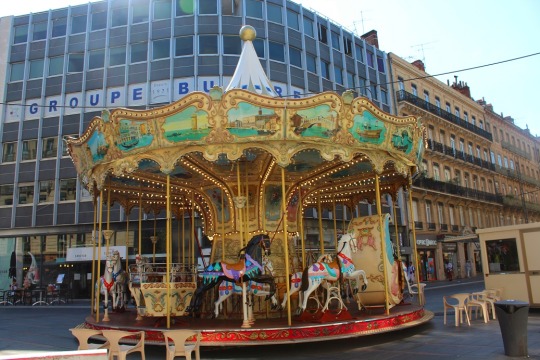
As mentioned, Rob had been spending some time at Airbus, providing product support. Through work, he made a friend at Airbus (Julien), who invited us over for a late dinner at his place. Julien’s girlfriend and I spent the day sightseeing in Toulouse. At dinner, Julien, prepared us duck soaked in red wine, served with rice, French pâté, cheeses of all varieties, meats, and more. Then we washed it all down with some rum, where our new friend showed us how to prepare it properly. Julien told us about his home country; a tiny island nestled to the east of Madagascar. A fun and delightful way to spend our last night in Toulouse.
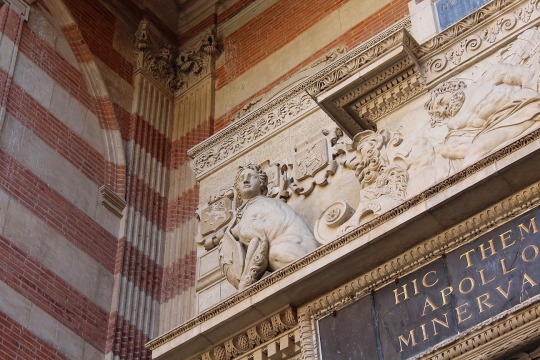


[a free tour inside the Capitole de Toulouse Building, pictured above]
To sum up a few interesting facts I learned in my first few days in France:
There’s a TV tax - used to fund local French TV networks.
Business isn’t always open – With Paris being the exception, hours of operation tend to vary in France. Sometimes it’s too late in the day for a croissant at a café. Or sometimes it’s too early for dinner and all restaurants don’t open until 7:30 PM. A way to avoid this is by going to bakeries for baked goods and then going to a local park. It’s much more efficient if you’re on the go, downside being you miss the outdoor café on the street atmosphere. Apart from food, boutiques are typically not open until 10 AM or so. Oh and Sundays? Forget about it. Many of the French truly live by exercising their day of rest. That goes for shops as well. Need not worry! There may be a local outdoor market open.
Bakeries are no joke – Bread is the staple of this country. It was a major player in the French Revolution. Seeing passersby with a baguette in their bag is in no way unusual. There’s a bakery around every corner, each item a soft, fluffy, piece of heaven. You can smell the bakeries in the street, making it impossible not to stop and snag a pastry.
Cheese is also no joke - The French cheese puts our cheese to shame. Don’t get me wrong, I enjoy a nice Wisconsin sharp cheddar as much as the next guy...but French cheese is savory on a whole other level!
Bordeaux
7/31/18 - Next stop, that’s right you guessed it; wine country. We decided to rent a car, a manual no less. A French car; a Peugeot. It was about a 2-hour drive north of Toulouse. Having experience driving a manual, I thought what a thrifty idea. Let’s not get into the narrow European one-way streets...eventually, we made it to Bordeaux. The city itself is just that, a city. Where were the acres of vineyards? We would soon travel 20 min east to Saint-Émilion to find out. But before we head out of the city, we stop by the Bordeaux Wine Museum. The Museum included a tasting and allowed you to explore the smells and sights of wine around the world. It was cool to see Yakima Valley (a Washington region) being recognized as a world-renowned wine within the museum. Wine is a big contributor to romance; the museum touched on that countless times. An interesting take on wine. After grabbing a French lunch buffet, we head out towards Saint-Émilion. The streets start to quiet and those vineyards finally make their grand appearance.



Our Airbnb sat within vineyards and the city we’d just left behind was a world away. This is the kind of countryside life where you can really forget about your troubles. The next day we had an electric bike tour planned through the Saint-Émilion chateaus and little did we know what an exceptional experience it would turn out to be.
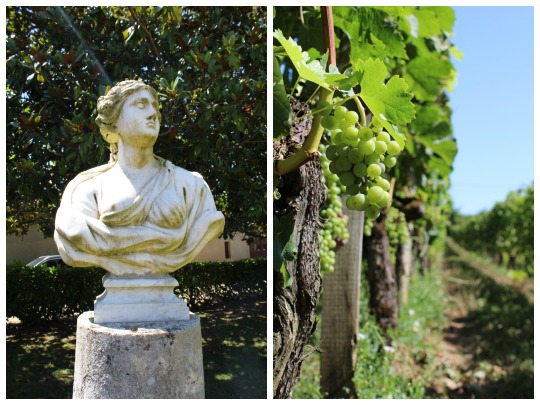
Our tour consisted of 8 riders and one guide. Our guide Julie was a local French gal, sharing her knowledge of the area’s history as we zigged and zagged through the back roads of vineyards. We learned about the importance of the soil; the area mostly comprised of limestone and clay - the perfect soil suitable for merlot and cab franc. The other 6 riders in our group were all Australian and what an entertaining lot they were! As we made our way through the hills, we eventually made our first stop at Château Panet. Here we walked through the Château where the wine was being made, learning about the process along the way. We ended the tour with an outdoor picnic of wine, cheeses, meats, and breads. We chatted with the rest of the group, learning that they all are from Melbourne. One of the riders complimented me on my accent, which was the first and likely the last time that will ever happen. Who ever thought an American accent could be “charming”?
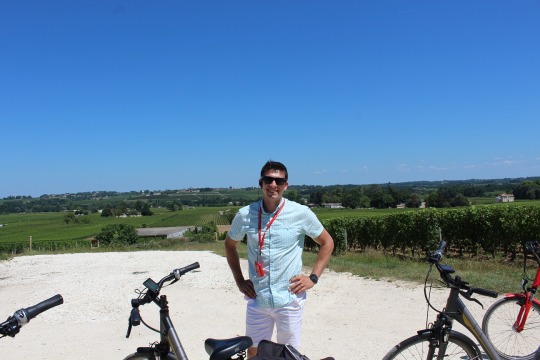

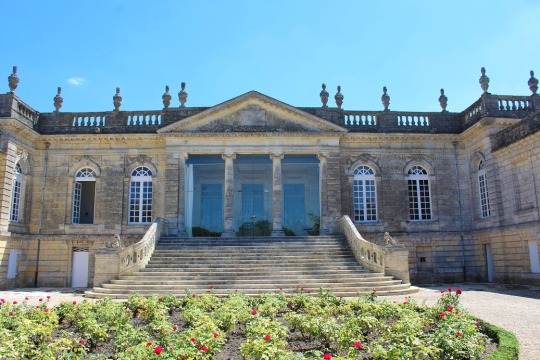
Our final stop on our tour was Château Saint-Georges, a true castle once owned by the king of France. We walked around the breathtaking grounds, stopping to try the smells and flavors in the garden. Each item in the garden was carefully chosen to help represent different notes within the wine. They also told us about how much the weather impacts the harvest, and why you often hear wine connoisseurs say things like, “2015 is an excellent vintage” or “that’s a good year”. We learned how you identify older wines vs younger by the color. We discovered so much about wine that we didn’t know, in such a short span of time.
Paris
8/3/18 - Paris, the world’s most visited city in the world, is its own breed. Comparing it to the rest of France isn’t a fair comparison really. We stayed at an Airbnb apartment within the heart of the city. Everything was within walking distance, with places like Notre Dame just a short walk away. Sure, in a city like Paris you’re going to come across a few homeless people digging through the trash and you have to be mindful of the possibility of pickpockets. If you’re able to avoid this and/or not allow it to spoil your visit, Paris can be very charming. Keeping a loose agenda and simply walking along the river, stumbling across places as you go, is the best way to do it. We stopped by a cafe, where a friend of a friend had just opened business (Jozi Cafe). He gave us some great advice on things to see and things to avoid. We joked with him about how he’d never been to the Louvre, much like we’ve never gone on Ride the Ducks in Seattle and how you’re often not the tourist in your own city. We visited Shakespeare and Co. bookstore to check out the 1920′s gathering spot for famous writers such as Ernest Hemingway and F. Scott Fitzgerald. We even bought Moveable Feast by Ernest Hemingway, a nonfiction that he wrote describing his time in Paris. Don’t forget to have the store clerk stamp your book with a Shakespeare & Co. stamp before you go!
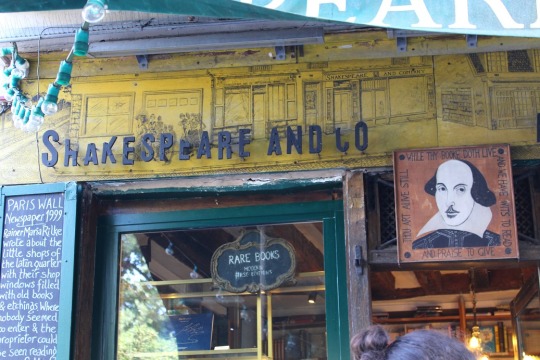


The Eiffel Tower - the symbol of romance in Paris. You can find an Eiffel Tower in the states on shirts, bags, or home decor. Seeing it in person really depicts its grandness. We needn’t bother go up the tower; we simply wanted to see it up close and in-person. Our 4th Wedding Anniversary we spent at a restaurant on the water, just beneath the tower. While enjoying our meal and our view, we did our favorite thing to do when we travel; people watch. We noticed our server speaking Spanish to the table to our right and French to the table on our left. He spoke English to us, so this was pretty impressive how he could just switch gears in a matter of moments. Tipping is not a custom in France, but you can certainly leave one if you feel the service was superb. While the boat tour on the river had been going on for hours, we opted to skip it during the day. The weather was hot, muggy, and uncomfortable. Instead, we did the tour during the sunset which proved to be both romantic and a much more comfortable and rewarding experience.


We spent our last day at The Louvre. We managed to see all of our favorites within 3 hours. The renaissance paintings being our favorite. Liberty Leading the People left the biggest impression on me. It was a must see and I wouldn’t recommend skipping it if you’re in Paris. Overall, we loved France and have every intention of visiting again one day. Travelling really teaches you a lot of lessons and opens your eyes to the big beautiful world out there. You also learn a lot about your own country through the perspective of other countries. Our craving for travel continues so stay tuned! We aren’t certain where our next trip will be. Brazil, Hong Kong, Singapore, Iceland, and the UK are all on the horizon. Thanks for reading; until next time.
2 notes
·
View notes